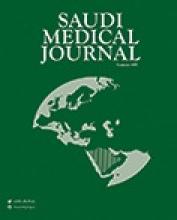To the Editor
I have 2 comments on the outstanding study by Morsy et al1 on the spectrum of congenital heart diseases (CHD) in Down syndrome (DS) patients.
First, the authors addressed a higher frequency of atrioventricular septal defects (AVSD) (40.7%) in Al-Madinah region compared with the other regions in the Kingdome of Saudi Arabia (KSA), namely Asser (22.8%), Riyadh (14.8%), and Jeddah (12%). However, it was comparable with that reported in Alhassa (38.4%).1 The authors also estimated a lower cumulative frequency AVSD in DS patients in KSA (25.6%)1 compared with 50% reported worldwide.2 The authors addressed 2 limitations that might explain the variations in the frequency of various forms of CHD, including AVSD among different regions in KSA as well as that reported worldwide.2 These included the retrospective nature of the study and small size DS cohort.1 I presume that the following methodological limitation might be additionally contributory. It is related to the echocardiographic evaluation of the studied CHD, particularly AVSD. My assumption is based on the following 2 points: 1) The sound understanding of the basic morphology and associated lesions in AVSD is an essential key to the prompt diagnosis. The common features of AVSD are the following: inlet outlet disproportion; absence of the atrioventricular muscular septum; abnormal position of the left ventricular papillary muscles; abnormal configuration of the atrioventricular valves; and, cleft in the left atrioventricular valve. These are all predicated by a sprung atrioventricular junction. Anatomic variations in AVSD with intact septal structures are increasingly reported that might be more common than previously thought.3 I presume that there were variable awareness of the involved pediatric echocardiographers on the anatomic components of AVSD, particularly the atypical types. This will be obviously mirrored on their proficiencies and skills in detecting AVSD. 2) In Morsy et al’s1 study, 2-dimensional echocardiography (2-DE) was employed to diagnose various forms of CHD.1 With the advances in technology and understanding the anatomic variants of AVSD, the standard 2-DE might be no longer the optimal method for the morphologic and functional evaluation of this lesion, particularly malformations of the atrioventricular valves. It is therefore, expected that when using 2-DE, a significant number of AVSD cases might be miscalculated. Alternatively, 3-DE could better enhance the detection of AVSD and provide accurate anatomic reconstructions of the common atrioventricular junction.4
Second, cardiovascular magnetic resonance (CMR) has recently expanded its role in the diagnosis and management of CHD and acquired heart diseases in the pediatric patients. It provides much diagnostic information to guide decisions.5 I presume that conducting large scale multicenter studies in KSA employing CMR could better delineate the exact prevalence and pattern of CHD in the pediatric population, particularly DS patients.
Reply from the Author
The authors appreciate the correspondences from Dr. Al-Mendalawi, which reflects the value of this study. In response to the raised points: First, there was a higher frequency of AVSD (40.7%) in Al-Madinah region and in Alhassa (38.4%), compared with the other regions in the Kingdome of Saudi Arabia, namely Asser (22.8%), Riyadh (14.8%), and Jeddah (8.87%). This wide range of AVSD is well documented in other international studies (ranging from 18-63%).6-8 The presumption of adding a methodological limitation “the echocardiographic evaluation of the studied CHD” was not applicable; 1) as we clearly stated in different parts of the study that the intended AVSD is the (complete type), and all the involved pediatric echocardiographers agreed on the anatomic components of complete type AVSD. Also, all the involved pediatric cardiologists are well trained and skilled and can differentiate between typical and atypical AVSD (despite the scarcity of the atypical types). 2) Although many advances in technology and recent methods to understand different cardiac defects (foe example, 3-DE & CMR), but the 2-DE remains the most commonly used method in the epidemiological (screening) studies of the cardiac defects carried out on large cohorts9,10 (comparing the cost, time, and effort). The use of advanced technology is better directed to the diagnosis and management of atypical CHD rather than screening issues.
Hany M. Abo-Haded
Department of Pediatrics Mansoura University Mansoura, Egypt
Student Corner
We invite students from a variety of medical disciplines to submit original contributions based on their supervised research.
The Student Corner of Saudi Med J aims to help students explore research opportunities and network with other peers and mentors in the same field.
Submission Guidelines
Submitted Abstracts should include the following:
Title should be descriptive
Author’s names and affiliation(specify college level/year, academic degree of Senior Author)
Abstract must be structured and not more than 300 words
The following are the typical headings:
Objectives (background, why the study was done, specific aims)
Methods (setting, date of study, design, subjects, intervention and analysis)
Results (findings, data and statistical tests) and
Conclusion (general interpretation of results)
General Information on Abstract Submission
Submitted Abstracts should be co-authored by a Senior Supervisor
Abstracts will be reviewed by Student’s Corner Section Editor
There is no fee to submit an Abstract
Ethical Approval should be provided
Non-indexed materials
- Copyright: © Saudi Medical Journal
This is an open-access article distributed under the terms of the Creative Commons Attribution-Noncommercial-Share Alike 3.0 Unported, which permits unrestricted use, distribution, and reproduction in any medium, provided the original work is properly cited.






